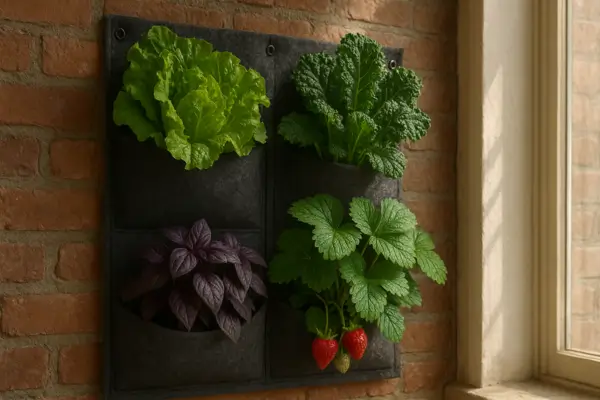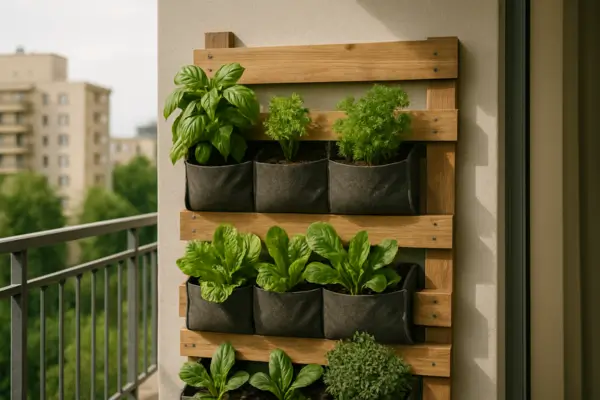Introduction:
The Beauty of Vertical Gardening for Urban Permaculture
In crowded cities where green space is scarce, vertical gardening offers a brilliant solution for urban dwellers craving a connection to nature. By growing plants upward instead of outward, these space-saving systems transform bare walls, balconies, and tiny patios into thriving green oases. But vertical gardens aren’t just pretty—they’re a cornerstone of urban permaculture, a sustainable approach to growing food and nurturing ecosystems in man-made environments.
Why Vertical Gardening is Perfect for Urban Permaculture
Traditional gardens require sprawling land, but vertical gardens defy that limitation. Whether you’re working with a fire escape, a balcony railing, or a sunny kitchen wall, you can cultivate herbs, vegetables, and flowers in stacked planters, hanging pockets, or repurposed materials like pallets and PVC pipes.
Key Benefits of Vertical Gardens
✔ Space-Saving Magic – Grow more in less square footage, ideal for apartments and small yards.
✔ Improved Air Quality – Plants filter pollutants and boost oxygen levels in urban settings.
✔ Sustainable Food Production – Harvest fresh herbs, greens, and even small veggies at home.
✔ Aesthetic & Mental Wellness – Lush greenery reduces stress and beautifies concrete jungles.
The Rise of Urban Permaculture & DIY Accessibility
As cities embrace sustainability, urban permaculture—a way to work with nature rather than against it—has gained momentum. Vertical gardens align perfectly with this philosophy, allowing anyone to create a productive, eco-friendly garden without needing a backyard. Plus, with simple DIY projects using recycled materials, you don’t need a big budget—just creativity and a love for growing.
Whether you’re a seasoned gardener or a beginner, vertical gardening opens up a world of possibilities. Ready to turn your urban space into a green paradise? Let’s dig into the best DIY projects to get you started! 🌿
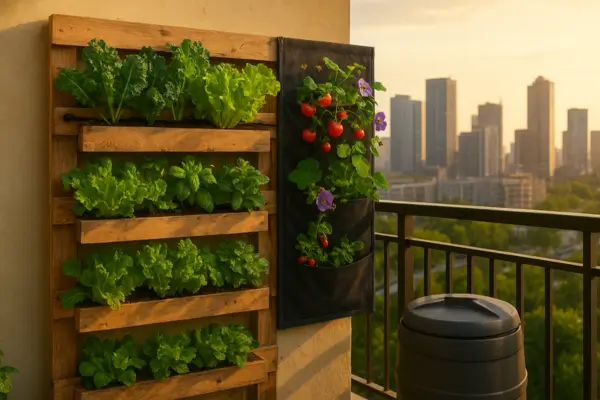
Why Choose Vertical Gardening for Urban Permaculture?
In concrete-dominated cities, every square inch of growing space matters. Vertical gardening isn’t just a trend—it’s a smart, sustainable solution that unlocks the full potential of urban permaculture. Here’s why you should consider going vertical:
1. Space Efficiency: Grow More in Less Space
Urban living often means cramped balconies, postage-stamp patios, or no yard at all. Vertical gardens maximize every inch by growing upward instead of outward.
- Perfect for apartment dwellers—turn blank walls, railings, or windowsills into productive green spaces.
- Grow herbs, greens, and even compact veggies without sacrificing floor space.
- Ideal for renters—many vertical systems are portable and non-permanent.
2. Better Plant Health: Fewer Pests, Stronger Growth
Unlike crowded ground gardens, vertical setups improve airflow around plants, which:
- Reduces fungal diseases (like powdery mildew) caused by stagnant moisture.
- Discourages soil-dwelling pests (slugs, snails) from reaching your crops.
- Allows more sunlight exposure for even growth on all levels.
3. Water Conservation: Smart Hydration for Dry Cities
Vertical gardens can be more water-efficient than traditional beds when designed right:
- Drip irrigation and self-watering systems deliver moisture directly to roots, minimizing waste.
- Less water evaporation compared to horizontal gardens (since soil isn’t as exposed).
- Collect rainwater in wall-mounted systems for a closed-loop solution.
4. Year-Round Gardening: Fresh Food in Every Season
Don’t let cold winters or scorching summers stop you:
- Outdoor setups extend growing seasons (use frost cloth or shade nets as needed).
- Indoor vertical gardens (with LED grow lights) let you harvest herbs and greens 365 days a year.
- Rotate crops seasonally—try lettuce in spring, cherry tomatoes in summer, and kale in fall.
5. Biodiversity Support: A Mini Ecosystem on Your Wall
Even small vertical gardens boost urban biodiversity:
- Flowering plants (like nasturtiums or lavender) attract pollinators (bees, butterflies).
- Herbs like basil and mint repel harmful insects while luring beneficial ones.
- Creates micro-habitats for city wildlife, from ladybugs to songbirds.
The Bottom Line
Vertical gardening solves urban permaculture’s biggest challenges: limited space, water scarcity, and pest pressure. By growing up, you’ll save resources, harvest more food, and bring nature back into the city—one wall at a time.
Ready to start? Check out our DIY project ideas to build your own! 🌱
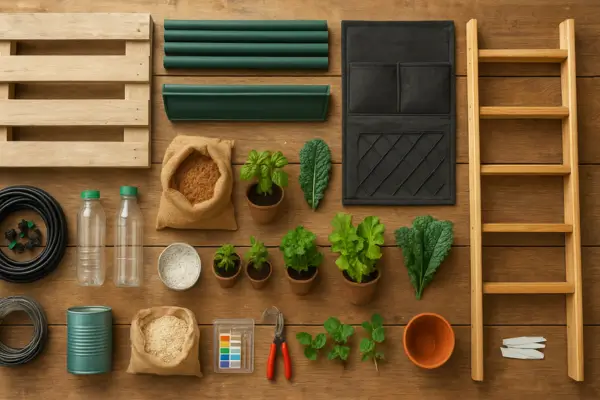
Essential Materials for DIY Vertical Gardens: Build Your Urban Oasis
Creating a thriving vertical garden starts with gathering the right materials. Whether you’re repurposing household items or investing in specialized systems, here’s your complete checklist to get growing upward!
Structural Elements: The Backbone of Your Garden
Your vertical garden needs a sturdy framework to support plant life:
- Wooden pallets (upcycled into instant planters)
- PVC pipes (drilled for tower gardens)
- Rain gutters (perfect for linear planting)
- Fabric pocket organizers (space-saving herb gardens)
- Trellises & wire grids (for climbing plants)
- Ladder shelves (multi-tiered planting stations)
Pro Tip: Always check structural weight limits for wall-mounted systems!
Containers & Planters: Creative Upcycling Ideas
Give everyday items new life as plant homes:
- Plastic bottles (cut horizontally or vertically)
- Tin cans (painted for colorful accents)
- Shoe organizers (fabric pockets for herbs)
- Wooden wine crates (rustic wall planters)
- Ceramic pots (attached to vertical boards)
- Burlap sacks (breathable hanging planters)
Bonus: Look for food-safe containers when growing edibles.
Soil & Compost: The Lifeblood of Your Garden
Vertical gardens need special growing media:
- Lightweight potting mix (avoid dense garden soil)
- Coconut coir (excellent water retention)
- Perlite/vermiculite (improves drainage)
- Worm castings (nutrient-rich fertilizer)
- Slow-release organic fertilizer (for sustained feeding)
Key Requirement: Your mix should hold moisture while preventing soggy roots.
Smart Irrigation Solutions
Keep plants hydrated with these water-wise systems:
- Drip irrigation kits (with adjustable emitters)
- Self-watering planters (reservoir systems)
- Wicking beds (capillary action watering)
- Spray bottle/mister (for small indoor setups)
- Watering globes (for vacation care)
Water-Saving Hack: Add water-absorbing polymer crystals to soil mix.
Plant Selection: Choose Your Vertical Garden Stars
Not all plants thrive vertically – these are your best bets:
Herbs (Perfect for Beginners)
- Basil, thyme, oregano, mint, chives
Leafy Greens
- Lettuce, spinach, kale, arugula
Compact Vegetables
- Cherry tomatoes, dwarf peppers, bush beans
Climbing Plants
- Peas, cucumbers, pole beans, nasturtiums
Ornamental Touches
- Pothos, ferns, succulents, trailing petunias
Planting Tip: Place thirstier plants at the bottom, drought-tolerant varieties up top.
Optional But Helpful Extras
- pH test kit (monitor soil health)
- Pruning shears (for maintenance)
- Grow lights (indoor supplementation)
- Weatherproofing sealant (for outdoor wood)
- Plant markers (track your varieties)
With these materials gathered, you’re ready to transform any blank wall or balcony into a lush, productive vertical garden. Remember: the best systems often combine recycled materials with a few strategic purchases for optimal results.
Coming Next: Step-by-step guides to building 5 easy vertical garden projects using these materials! Which one will you try first?
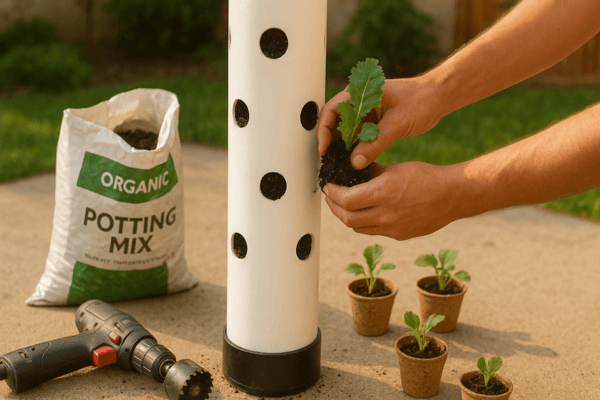
5 Easy DIY Vertical Garden Projects for Urban Growers
Transform your small space into a lush paradise with these beginner-friendly vertical garden ideas. Each project uses affordable or repurposed materials to create stunning green walls packed with herbs, flowers, and even veggies!
1. Pallet Vertical Garden: Rustic Charm Meets Functionality
Materials:
- 1 wooden pallet (heat-treated, not chemically treated)
- Landscape fabric or burlap
- Staple gun
- Potting soil
- Plants of choice
Step-by-Step:
- Sand the pallet to remove splinters
- Line the back and sides with landscape fabric (staple in place)
- Fill with soil through the slats
- Plant through the front openings
- Let rest horizontally for 2 weeks before hanging vertically
Best Plants:
- Drought-tolerant: Succulents, sedums
- Culinary favorites: Thyme, oregano, sage
- Sweet treats: Alpine strawberries
*Pro Tip: Use pallet with wider gaps (3-4″) for easier planting.*
2. Hanging Bottle Planters: Eco-Friendly Upcycling
Materials:
- 2L plastic bottles
- Sharp scissors/box cutter
- Rope or chain
- Potting mix
- Small plants
Assembly Guide:
- Cut bottles horizontally (leave top third as a lid or remove completely)
- Poke drainage holes in bottom
- Thread rope through bottle neck or punched holes
- Fill with soil and plants
- Hang in sunny spot
Ideal Plants:
- Herbs: Basil, mint, parsley
- Flowers: Petunias, lobelia
- Leafy greens: Spinach, lettuce
Bonus: Create a cascading effect by hanging bottles at different heights.
3. PVC Pipe Tower Garden: Space-Saving Veggie Factory
Materials:
- 6″ diameter PVC pipe (4-5′ tall)
- End cap
- Drill with 2″ hole saw
- Potting soil
- Seedlings
Construction:
- Drill planting holes in staggered pattern
- Cap the bottom
- Stand pipe vertically in stable base
- Fill with soil while inserting plants in holes
- Top-plant with another crop
Top Performers:
- Leafy greens: Lettuce, spinach, kale
- Root crops: Radishes, green onions
- Compact herbs: Chives, cilantro
Watering Hack: Insert a perforated tube down the center for deep watering.
4. Gutter Garden System: The Salad Bar Solution
Materials:
- Vinyl rain gutters (10′ sections)
- End caps
- Brackets and screws
- Lightweight potting mix
- Plants
Installation:
- Cut gutters to desired length
- Attach end caps with waterproof sealant
- Mount using brackets (slight tilt for drainage)
- Fill with soil
- Plant your greens
Perfect For:
- Strawberries (hanging fruits stay clean)
- Salad greens: Arugula, mesclun mix
- Quick-growing herbs: Cilantro, dill
- Edible flowers: Marigolds, pansies
Space Saver: Install multiple tiers with 12″ between levels.
5. Fabric Pocket Garden: Instant Green Wall
Materials:
- Hanging shoe organizer (canvas or felt)
- Potting soil
- Assorted plants
- S-hooks or curtain rod
Setup:
- Hang organizer on wall, fence, or railing
- Fill pockets 2/3 with soil
- Add plants and top up with soil
- Water thoroughly (expect some drainage)
Top Picks:
- Microgreens: Pea shoots, sunflower sprouts
- Trailing plants: Ivy, pothos, philodendron
- Small herbs: Parsley, thyme, marjoram
- Colorful annuals: Impatiens, begonias
Maintenance Tip: Rotate organizer periodically for even growth.
Final Thoughts
These five projects prove you don’t need a yard to grow fresh food and beautiful plants. Whether you choose the rustic pallet, high-tech PVC tower, or super-simple shoe organizer, you’ll be harvesting your vertical garden in no time!
Which project speaks to you? Start with one that matches your space, sunlight, and gardening goals. Happy vertical growing! 🌿
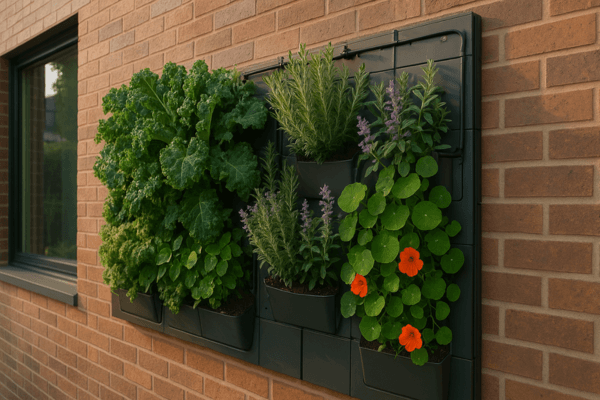
Advanced Vertical Garden Ideas for Serious Urban Growers
Ready to take your vertical gardening to the next level? These innovative systems combine cutting-edge technology with sustainable practices to maximize yields in minimal space. Perfect for urban homesteaders and tech-savvy gardeners!
1. Living Walls with Modular Panels (The Ultimate Green Facade)
How It Works:
Modular living wall systems use interlocking panels filled with growing medium that can cover entire walls or fences. These sophisticated setups often include built-in irrigation for effortless maintenance.
Key Features:
- Self-contained panels (typically 1’x1′ or 1’x2′ sizes)
- Integrated drip irrigation with timers
- Optional water recirculation systems
- Durable synthetic felt or recycled plastic construction
Best Plants:
- Ornamental: Ferns, philodendrons, spider plants
- Edible: Strawberries, leafy greens, dwarf herbs
- Flowering: Begonias, impatiens, lobelia
Pro Tips:
✓ Start with a small 4-panel system before scaling up
✓ Use lightweight expanded clay pellets as growing medium
✓ Install on north-facing walls to prevent overheating
Ideal For:
- Apartment building common areas
- Restaurant exterior walls
- Office building atriums
2. Aquaponics Vertical Systems (The Fish-Powered Garden)
How It Works:
This closed-loop ecosystem combines aquaculture (fish farming) with hydroponics. Fish waste provides nutrients for plants, while plants filter and clean the water for fish.
System Components:
- Fish tank (often at the base)
- Vertical grow towers above the tank
- Water pump and piping
- Biofilter to convert fish waste
Why It’s Revolutionary:
- Produces both fish and vegetables
- Uses 90% less water than soil gardening
- No chemical fertilizers needed
- Faster plant growth rates
Best Fish/Plant Combinations:
- Tilapia + leafy greens
- Goldfish + herbs
- Koi + flowering plants
Maintenance Requirements:
• Daily fish feeding
• Weekly water testing
• Monthly system checks
Perfect For:
- Urban homesteaders
- STEM education programs
- Sustainable restaurants
3. Hydroponic Tower Gardens (The Future of Farming)
How It Works:
These soilless systems deliver nutrient-rich water directly to plant roots through vertical towers, allowing for incredibly dense planting and rapid growth.
Cutting-Edge Features:
- Aeroponic technology (misting roots with nutrients)
- LED grow lights for indoor setups
- Automated pH balancing in advanced models
- Smartphone-controlled systems available
Growth Advantages:
→ 3x faster growth than soil
→ 90% more yield per square foot
→ Year-round production possible
→ No weeding required
Top Crops:
- Leafy greens (lettuce, kale, chard)
- Herbs (basil, cilantro, mint)
- Vine crops (dwarf tomatoes, peppers)
- Flowers (petunias, marigolds)
Installation Options:
• Freestanding outdoor towers
• Indoor smart gardens
• Commercial-scale systems
Who Should Try This:
- Tech enthusiasts
- Urban farmers
- Health-conscious families
- Restaurant owners
Choosing Your Advanced System
Consider these factors before investing:
- Space available (indoor vs outdoor)
- Budget (from $200 DIY to $5,000+ commercial)
- Time commitment for maintenance
- Goals (aesthetics vs food production)
The Future Is Vertical
These advanced systems represent the cutting edge of urban agriculture. While they require more initial investment than basic vertical gardens, their incredible productivity and sustainability make them worthwhile for serious growers.
Ready to upgrade? Start with one tower or panel system to learn the basics before expanding your vertical farm! Which of these futuristic growing methods intrigues you most?
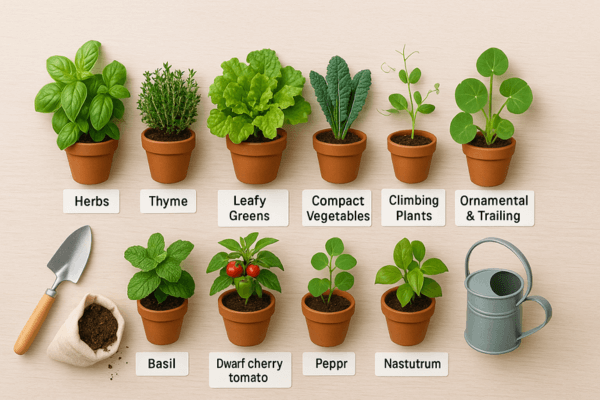
Best Plants for Urban Vertical Gardens: A Curated Selection
Transforming your vertical garden into a thriving oasis starts with choosing the right plants. These carefully selected varieties offer the perfect balance of productivity, compact growth habits, and visual appeal for urban growing conditions.
1. Culinary Herbs: Flavorful & Space-Efficient
Perfect for kitchen gardens and beginner growers
Top Picks:
- Basil (Genovese or bush varieties)
- Parsley (flat-leaf or curly types)
- Chives (regular or garlic chives)
- Rosemary (upright or trailing varieties)
- Thyme (English or lemon thyme)
- Mint (contain in separate pockets to prevent spreading)
Why They Excel:
✓ Require minimal root space
✓ Frequent harvest encourages bushier growth
✓ Most thrive in 4-6 hours of sunlight
✓ Natural pest-repellent properties
Pro Tip: Create a “pizza garden” vertical planter with basil, oregano, and thyme for fresh toppings!
2. Leafy Greens: Continuous Harvest Crops
Ideal for salad lovers and quick yields
Best Performers:
- Kale (Dwarf Blue Curled or Red Russian)
- Swiss Chard (Bright Lights mix for color)
- Arugula (fast-growing with peppery flavor)
- Spinach (Baby Leaf varieties)
- Lettuce (Butterhead, Oakleaf, or Lollo Rossa)
- Asian Greens (Tatsoi, Mizuna, Pak Choi)
Growth Advantages:
→ Ready to harvest in 30-45 days
→ Many are cut-and-come-again varieties
→ Tolerate partial shade conditions
→ Excellent for interplanting
Harvesting Tip: Use the “outer leaf” method to extend production for months.
3. Compact Vegetables: Big Flavor in Small Packages
For gardeners wanting more substantial harvests
Space-Smart Choices:
- Cherry Tomatoes (Tumbling Tom or Tiny Tim)
- Dwarf Peppers (Mini Bell or Lunchbox varieties)
- Bush Beans (Mascotte or French Dwarf)
- Dwarf Eggplants (Fairy Tale or Patio Baby)
- Mini Cucumbers (Bush Slicer or Spacemaster)
Special Considerations:
• Choose determinate (bush) tomato varieties
• Provide small trellises for vining plants
• May require more frequent watering
• Best for south-facing locations
Yield Booster: Incorporate slow-release organic fertilizer at planting time.
4. Edible Flowers: Beauty Meets Function
Add color and gourmet flair to your garden
Must-Grow Varieties:
- Nasturtiums (peppery leaves and flowers)
- Calendula (vibrant orange petals)
- Borage (star-shaped blue flowers)
- Pansies (mild, colorful additions)
- Violas (delicate winter-hardy blooms)
Dual-Purpose Benefits:
✔ Brighten up vertical spaces
✔ Attract beneficial insects
✔ Culinary uses in salads and desserts
✔ Many have medicinal properties
Design Idea: Plant trailing nasturtiums to cascade down vertical structures.
5. Pollinator Magnets: Eco-Friendly Choices
Support urban biodiversity while gardening
Top Attractors:
- Lavender (English or French varieties)
- Dwarf Sunflowers (Sunspot or Teddy Bear)
- Bee Balm (Monarda didyma)
- Salvia (Victoria Blue or Hot Lips)
- Agastache (hummingbird favorite)
Ecological Impact:
→ Supports declining bee populations
→ Increases pollination of edible plants
→ Creates habitat for beneficial insects
→ Many are drought-tolerant once established
Companion Planting: Intermix with vegetables to boost yields naturally.
Plant Selection Guidelines for Success
- Light Requirements:
- Full sun (6+ hours): Tomatoes, peppers, lavender
- Partial shade (3-6 hours): Lettuce, spinach, mint
- Shade tolerant (2-3 hours): Parsley, chives, ferns
- Root Depth Needs:
- Shallow (6-8″): Herbs, lettuce, strawberries
- Medium (8-12″): Kale, chard, dwarf peppers
- Deep (12-18″): Tomatoes, beans (require larger containers)
- Seasonal Considerations:
- Cool season: Lettuce, kale, pansies
- Warm season: Basil, tomatoes, nasturtiums
- Year-round: Rosemary, thyme (in mild climates)
- Maintenance Level:
- Low: Succulents, herbs, perennial flowers
- Moderate: Leafy greens, bush beans
- High: Fruiting vegetables, annual flowers
By carefully selecting plants that match your growing conditions and gardening goals, your vertical garden can become both productive and visually stunning. Remember to start with a few easy varieties and expand as you gain confidence!
What will you plant first in your vertical garden? Share your plant wishlist in the comments!
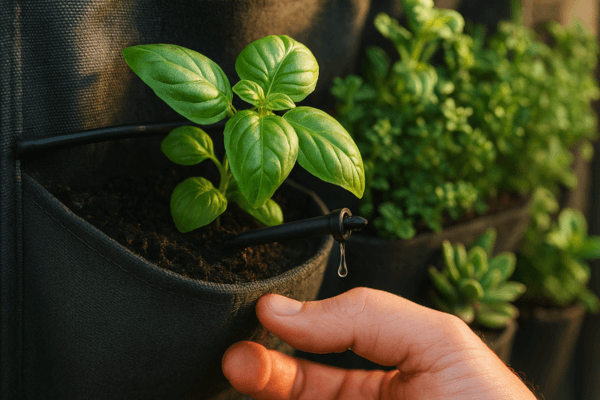
Essential Maintenance Tips for Thriving Vertical Gardens
Keeping your vertical garden lush and productive requires a bit of know-how. Unlike traditional gardens, vertical setups have unique needs when it comes to watering, soil care, and plant health. Follow these expert tips to ensure your green wall stays vibrant year-round!
1. Smart Watering: Quench Thirst Without Drowning Roots
Vertical gardens dry out faster than ground-level beds but are also prone to overwatering. Here’s how to strike the perfect balance:
✅ Use drip irrigation or self-watering systems for consistent moisture (ideal for busy urban gardeners).
✅ Water in the early morning to reduce evaporation and fungal risks.
✅ Check soil moisture with your finger—damp (not soggy) 1″ below the surface is ideal.
✅ Group plants by water needs (e.g., keep thirsty ferns separate from drought-tolerant succulents).
🚫 Avoid:
- Spraying foliage directly (promotes disease)
- Letting water pool at the base (root rot risk)
Pro Tip: Install a rainwater collection system for eco-friendly irrigation!
2. Soil Health: Feed Your Garden from the Ground Up
Vertical planters exhaust nutrients faster due to limited soil volume. Keep plants thriving with these practices:
🌱 Refresh compost every 4–6 weeks to replenish nutrients (worm castings work wonders!).
🌱 Mulch with coconut coir or straw to retain moisture and regulate temperature.
🌱 Use lightweight potting mix (avoid garden soil, which compacts and hampers drainage).
🌱 Flush soil monthly to prevent salt buildup from fertilizers (especially in hydroponic systems).
Bonus: Add mycorrhizal fungi to boost root health and nutrient uptake.
3. Sunlight Management: Right Plant, Right Place
Not all vertical surfaces receive equal light. Maximize growth by:
☀️ Full sun (6+ hours): Tomatoes, peppers, lavender, rosemary
⛅ Partial shade (3–6 hours): Lettuce, mint, parsley, begonias
🌥️ Low light (2–3 hours): Pothos, ferns, chives
🔍 Monitor for signs of stress:
- Leggy growth or pale leaves? → Needs more light
- Scorched leaves? → Too much direct sun (add shade cloth)
Design Hack: Rotate planters weekly to ensure even light distribution.
4. Pest Control: Natural Solutions for a Healthy Garden
Vertical gardens can still attract pests, but chemicals aren’t your only option:
🐞 Companion planting:
- Marigolds repel nematodes
- Basil deters whiteflies and mosquitoes
- Nasturtiums lure aphids away from veggies
🌿 Organic treatments:
- Neem oil (for mites, aphids, and mildew)
- Insecticidal soap (soft-bodied pests)
- Diatomaceous earth (slugs and beetles)
⚠️ Act fast! Inspect plants weekly—early intervention prevents infestations.
5. Seasonal Care: Adapt Through the Year
Extend your garden’s productivity with seasonal adjustments:
❄️ Winter:
- Move sensitive plants indoors or use frost blankets
- Switch to cold-hardy greens (kale, spinach)
🌱 Spring:
- Refresh soil and prune dead growth
- Start warm-season seedlings (tomatoes, basil)
☀️ Summer:
- Shade delicate plants during heatwaves
- Mulch heavily to conserve water
🍂 Fall:
- Harvest and preserve herbs
- Plant garlic or overwintering flowers
Pro Tip: Keep a garden journal to track what works each season!
Bonus: Troubleshooting Common Issues
🔸 Yellow leaves? Could be overwatering or nutrient deficiency.
🔸 Slow growth? Check light levels and fertilize with liquid seaweed.
🔸 Mold or mildew? Improve airflow and reduce watering frequency.
Final Thought
A well-maintained vertical garden rewards you with beauty, fresh food, and a connection to nature—even in the smallest urban spaces. Which tip will you try first? Share your experiences in the comments!
Next Up: [Advanced Vertical Garden Hacks] or [How to Harvest Like a Pro]—let us know what you’d like to see! 🌿
Troubleshooting Common Vertical Garden Issues
Even the best-designed vertical gardens can run into problems. Don’t let these common challenges discourage you—here’s how to diagnose and fix them like a pro!
1. Drainage Problems: Saving Plants from Waterlogged Roots
Symptoms:
- Yellowing leaves
- Mushy stems
- Foul soil odor
- Slow growth
Solutions:
✔ Add drainage holes – Drill extra holes in containers if water pools.
✔ Use lightweight, well-draining soil – Mix in perlite or coarse sand (30% ratio).
✔ Elevate planters – Place pots on feet or racks to let excess water escape.
✔ Install a drip tray – For indoor setups, use trays with pebbles to elevate pots above standing water.
🚫 Avoid:
- Overwatering (check soil moisture before watering)
- Using non-porous containers without drainage
Pro Tip: Layer gravel or clay pebbles at the bottom of deep planters to improve drainage.
2. Wind Exposure: Keeping Your Garden Secure
Symptoms:
- Tipped-over planters
- Broken stems or torn leaves
- Soil drying out too fast
Solutions:
✔ Anchor structures – Use wall brackets, sandbags, or heavy bases for freestanding towers.
✔ Choose wind-resistant plants – Herbs (rosemary, thyme), succulents, or sturdy greens (kale).
✔ Install windbreaks – Use trellises, mesh screens, or outdoor fabric to diffuse strong gusts.
✔ Opt for heavier containers – Ceramic or wooden planters resist tipping better than plastic.
🌬️ For balconies/high-rise gardens:
- Cluster plants together to create a wind buffer.
- Avoid tall, top-heavy designs in windy areas.
3. Nutrient Deficiency: Feeding Your Plants Right
Symptoms:
- Pale or yellow leaves (nitrogen deficiency)
- Purple stems (phosphorus deficiency)
- Brown leaf edges (potassium deficiency)
- Stunted growth (general malnutrition)
Solutions:
✔ Organic fertilizer options:
- Compost tea (nutrient-rich liquid fertilizer)
- Worm castings (gentle, all-purpose boost)
- Fish emulsion (high in nitrogen)
- Seaweed extract (trace minerals)
✔ Fertilizing schedule:
- Leafy greens/herbs: Every 3–4 weeks
- Fruiting plants (tomatoes, peppers): Every 2 weeks
⚠️ Avoid over-fertilizing – Flush soil with water if you see salt buildup (white crust on soil).
Pro Tip: Rotate fertilizer types to provide a balanced nutrient profile.
4. Plant Overcrowding: Giving Roots Room to Thrive
Symptoms:
- Competing vines
- Mold or mildew from poor airflow
- Uneven growth (dominant plants shading others)
Solutions:
✔ Follow spacing guidelines:
- Herbs: 6–8″ apart
- Leafy greens: 4–6″ apart
- Fruiting plants (tomatoes/peppers): 12–18″ apart
✔ Prune aggressively:
- Pinch back fast-growing herbs (basil, mint).
- Remove yellowing or diseased leaves promptly.
✔ Use the “thinning” method:
Harvest entire plants (like lettuce) to create space for neighbors.
🌿 Better Alternatives to Crowding:
- Succession planting (replace harvested plants with new seedlings).
- Tiered designs (place shade-tolerant plants below taller ones).
Bonus: Quick Fixes for Other Common Issues
🔸 Pests? Spray with diluted neem oil or introduce ladybugs.
🔸 Leggy plants? Move to sunnier spots or add grow lights.
🔸 Soil drying too fast? Mix in water-retaining crystals or coconut coir.
Final Thought
Every gardening challenge has a solution! Which issue have you faced in your vertical garden? Share your fixes in the comments—your tip might help another urban gardener!
Next Up: [How to Revive a Struggling Vertical Garden] or [Seasonal Planting Guides]—let us know what you’d like to see! 🌱

Inspiration: Real-Life Urban Vertical Gardens That Will Amaze You
Urban spaces are bursting with creative vertical gardens that prove you don’t need a backyard to grow lush, productive greenery. From balcony jungles to community food forests, these real-world examples will spark your imagination and motivate you to start your own sky-high oasis!
1. The Apartment Balcony Food Forest (Toronto, Canada)
Gardeners: Mark & Priya, urban permaculture enthusiasts
Setup:
- Repurposed wooden pallets transformed into tiered herb and veggie planters
- Hanging gutter system for strawberries and salad greens
- DIY drip irrigation using recycled bottles
Key Features:
🌿 Grows 80% of their summer herbs and greens
🌿 Companion planting with marigolds to deter pests
🌿 Winter adaptation: Moves cold-sensitive plants indoors under grow lights
“We harvest daily—our morning omelets are packed with homegrown basil, chives, and cherry tomatoes!” – Priya
2. The Rooftop Honeycomb Haven (Brooklyn, New York)
Project: Community co-op garden on a converted warehouse roof
Design:
- Hexagonal modular planters made from upcycled shipping pallets
- Vertical aquaponics tower growing tilapia and leafy greens
- Pollinator corridor with lavender, sunflowers, and bee hotels
Impact:
🐝 Produces 200+ lbs of organic veggies annually for local food banks
🐝 Hosts educational workshops on urban beekeeping
🐝 Reduces building heat by 15°F in summer
“Our garden feeds both people and pollinators—it’s a true ecosystem.” – Carlos, project founder
3. The Parking Lot Paradise (Portland, Oregon)
Innovation: A former auto shop turned vertical farm
Standout Elements:
- Repurposed car tires stacked as potato towers
- Retired fire escape converted to a cascading strawberry garden
- Salvaged PVC pipes as vertical planters for beans and peas
Why It Works:
♻️ 100% recycled materials
♻️ Rainwater harvesting system
♻️ Trains homeless youth in urban agriculture skills
“We grow food and futures here.” – Lena, program director
4. The Living Wall Café (Melbourne, Australia)
Concept: Restaurant with an edible facade
Features:
- 40-foot hydroponic living wall with 150+ herb and microgreen varieties
- Daily harvest-to-table specials like wall-picked basil pesto
- AI-powered irrigation that adjusts to weather conditions
Customer Favorite:
🍃 “Choose Your Own Salad” – guests pick greens straight from the wall
“Our vertical garden reduces food miles to just 10 feet!” – Chef Marco
5. The Fire Escape Farm (Chicago, Illinois)
Gardener: Mr. Thompson, retired teacher
Ingenious Adaptations:
- Hanging shoe organizers stuffed with lettuce and spinach
- Mason jar herb garden suspended from railings
- DIY cold frame from old windows for winter growing
Secret to Success:
🌱 Uses reflective aluminum panels to maximize sunlight
🌱 Composts with a worm bin under the stairs
🌱 Shares harvests with neighbors in exchange for eggshells/coffee grounds
“At 82, I haven’t bought greens at the store in 7 years.” – Mr. Thompson
Community Projects Changing Cities
The High-Rise Honey Project (London, UK)
- 30+ balcony gardens linked across an apartment complex
- Shared pollination network boosts yields for all residents
- Weekly veggie swap meets on the rooftop
The Schoolyard Sky Farm (Tokyo, Japan)
- Students tend vertical rice paddies in repurposed rain gutters
- Math lessons calculate plant growth rates
- Supplies school cafeteria with fresh produce
What These Gardens Teach Us
- Start small – Even a single pallet or shoe organizer can yield impressive results
- Community matters – Shared gardens build connections and resilience
- Innovation beats limitations – No space? Look up!
- Sustainability pays off – These gardens save money and resources long-term
Which project inspired you most? Tag a friend who’d love to create something like this!
“The only limit is your imagination—and maybe your wall space!”
Conclusion
Vertical Gardening: Your Urban Permaculture Journey Starts Here
As we’ve explored, vertical gardening isn’t just a clever space-saving trick—it’s a revolutionary approach to urban permaculture that transforms concrete jungles into thriving edible ecosystems. Let’s revisit why growing upward changes everything:
Why Vertical Gardens Are Game-Changers
🌱 Space Maximizers – Turn blank walls, railings, and tiny balconies into productive green spaces
🌱 Eco-Warriors – Improve air quality, reduce urban heat, and support pollinators
🌱 Food Freedom – Harvest fresh herbs, greens, and veggies steps from your kitchen
🌱 Stress Relievers – Create living art that nourishes both body and soul
Remember Mr. Thompson’s fire escape farm? Or the Brooklyn rooftop that feeds hundreds? These aren’t fantasies—they’re real examples of what’s possible when we rethink “garden space” as any sunlit vertical surface.
Your Adventure Begins Small
You don’t need a rooftop or fancy system to start:
- Pick one project – A hanging bottle herb garden or a single pallet planter
- Use what you have – Old shoe organizers, gutters, or crates make perfect starters
- Grow what you love – Start with foolproof plants like basil, lettuce, or nasturtiums
Every expert gardener began with a single seedling. Your vertical jungle will grow one plant at a time!
Join the Movement!
📸 Show us your creations! Share photos of your vertical garden in the comments—we’d love to cheer you on and offer tips.
🌿 Connect locally – Search for “[Your City] Urban Gardening Group” to swap plants and ideas. Many communities have seed libraries and tool-sharing programs!
✉️ Stay inspired – Subscribe for weekly tips on:
- Space-smart gardening hacks
- Seasonal planting guides
- DIY projects using recycled materials
The concrete landscape is changing—one vertical garden at a time. Will yours be next? Grab some soil, repurpose that old shelf, and let’s grow upward together!
What’s your first vertical garden project going to be? Tell us below! ↓
“The best time to plant a garden was 20 years ago. The second best time is NOW.” – Chinese Proverb (Vertical Garden Edition!) 🌱✨

